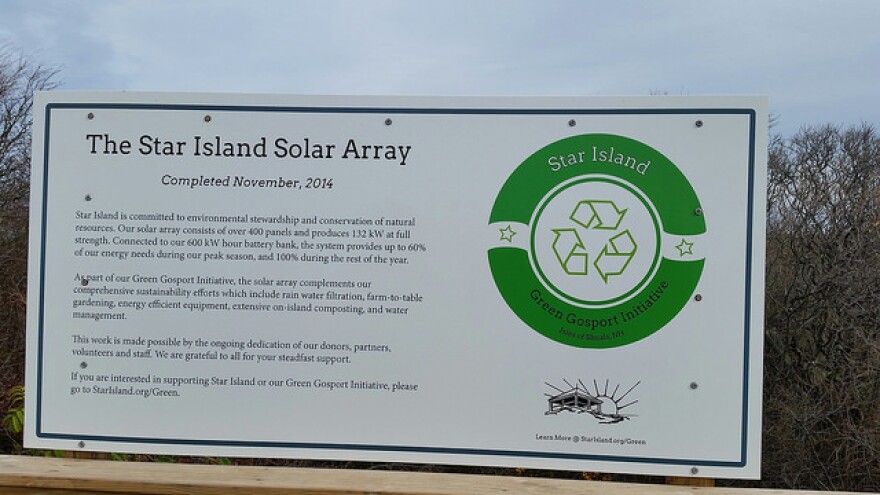Maine's island communities pay some of the highest energy costs in the country — up to 70 cents a kilowatt hour to light homes on some islands and up to a dollar more per gallon of heating oil than residents on the mainland.
But islanders are a resourceful bunch, and they're confronting the challenge with innovative solutions that make sense for the planet and for their pocketbooks.
The reason islands like Monhegan and Matinicus pay some of the highest electricity rates in the country can be summed up in one word: diesel. Until recently the cost of diesel, which is used to generate electricity, has been very high. So now, both islands are looking to invest in solar projects. And they're getting inspiration from some sparsely populated islands off the coast of New Hampshire.
"Off to the right you'll see there's three battery banks," says Richard Case, showing off Star Island's new power generation system that relies on a 420-panel solar array and a battery storage unit. "These are large cells. They're two-volt cells and they're what, about three feet wide by eight inches high by another two foot deep."

Star's is the largest solar array off the coast of northern New England. Until the new system was installed last year, the island relied exclusively on a pair of noisy, more polluting diesel-powered generators to do the job.
As the island's operators saw costs continue to increase, they realized they wanted a more sustainable solar solution.

"We were measuring 17,000 gallons of diesel fuel a year and that went into both generators, about 12,000 into generators and another 5,000 into steam and hot water heating," Case says.
He says the island replaced the old generators with newer, more efficient models, did away with the hot water boilers and has managed to save about 5,000 gallons of diesel this year. He expects more reductions over the coming year.
In the meantime, the island, which is operated as a nonprofit retreat and conference center from June through September, is now nearly 50 percent powered from the sun.

"The biggest difference between our system and theirs is we have that wind turbine," says Alex Brickett, the lead engineer at Shoal Marine Laboratory on nearby Appledore Island. It also has a "green grid," although smaller than Star's, with a 56 kilowatt solar array, a small wind turbine, three diesel generators and a battery bank.
"I guess the big thing we've learned from our system out here is solar is the best bang for our buck," he says. "I mean the cost of installing solar is not that much. That turbine all together cost like $75,000 to install it."

But the wind turbine generates 7.5 kilowatts of electricity, and Brickett says the solar panels cost about the same amount to install, they generate 56 kilowatts and their production is much more predictable and reliable.
Suzanne MacDonald, community energy director for the Island Institute, says addressing the energy challenge is the key to the long-term sustainability of island communities. She says island residents get it — they see the connection of burning fossil fuels to warming waters and ocean acidification and so they're investing in energy efficiency.

"On some of the islands where the electricity rates are not as high but the heating fuel costs are extremely high, heat pumps make a lot of sense, and so on islands like Peaks Island we've seen dozens and dozens of homeowners convert to heat pumps," she says. "It's making it so that they don't have to deal with the issues of barging fuel out to the island, it's saving them money on their monthly bills and I think a lot of folks are feeling more comfortable and feeling good about contributing to decreasing the amount of fossil fuels that their community is burning."
MacDonald says islands have also started purchasing LED light bulbs and weatherization services in bulk. And at the Island Institute's annual energy conference last week, participants also heard from their counterparts from as far away as Alaska, who are generating electricity using hydrokinetic river power.

"We've looked at some wind power, some solar thermal and have made the most progress with hydrokinetic power," says AlexAnna Salmon, the council president of Igiugig, Alaska, a small, remote village accessible only by air.
Salmon says the high cost of diesel was threatening the survival of her community, which is a world-class salmon fishery. But climate change, she says, has actually made using the technology to harness the nearby river possible.
"We're seeing a lot less of our lake freezing and not as severe ice breakups, so that will actually work with the hydrokinetic technology because ice breakup is the time period where we would take the device out of the water," Salmon says.
And the company that makes the device? Ocean Renewable Power, based in Portland, Maine.
Salmon says there's a lot the rest of the country can learn from the way islands and remote villages like hers are adapting.
Beyond 350: Confronting Climate Change is made possible by a grant from the Doree Taylor Charitable Foundation.




